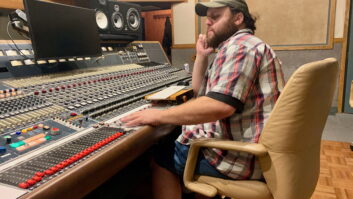(click thumbnail)The Yamaha AW4416 is a compact, self-contained audio workstation that allows the recording, editing, processing and mixing of audio, then outputs it or burns it to a CD.
It combines features found in some of Yamaha’s best products, including mixer technology inherited from the 02R and 03D mixers and signal processing adopted from an extensive heritage of effect boxes.
The AW4416 is cool to use, with a cluster of sample playback keys that let you drop in music loops and sound effects. It is also fun to watch, with motorized faders that dance during automated mixdowns. It makes the job easy for the producer while providing eye candy for clients visiting the studio to update their spots.
However, the Yamaha AW4416 would probably not be your first choice as a main production room tool. The company itself is targeting the AW4416 for the personal music studio community, as evident in the Tutorial manual, which walks the user through a music mix.
The depth of features it offers would be overkill in a hardwired radio production room. Also, it seems unable to export a polished product as a WAV file to insert directly into a station’s digital storage system.
This is not to say radio producers should look elsewhere. The AW4416 is an outstanding performer outside the station; for the independent producer involved in the advertising jingle marketplace, or the creation of longform audio with a cast of multiple voices, such as talking books or recorded drama. Here, its extensive roster of features would not be neglected.
(click thumbnail)
If you build it …
Much like an expensive Christmas present, there is “some assembly is required” with the AW4416. Out of the box, it is necessary to open the case and install the CD-R unit and the disk drive, then format the disk. Enclosed instructions make it as easy as plugging in a mic.
Product CapsuleThumbs Up:


- Impeccable audio specs
- Self-contained and compact
- Automated mixdown
- Expandable disk capacity and I/O options
- Yamaha effects
- Version 2 adds to the MIDI functionality and provides enhanced user interfaces
Thumbs Down
- Jog wheel feels flimsy
- Cannot export WAV file except to media
- Ironically, too many features for plain radio production
Price: $3,799
For information, contact Yamaha in California at (714) 522-9011 or visit the Web site at www.yamahapro.com.
The AW4416 offers 16 tracks, each consisting of eight “virtual” tracks that may contain alternate takes. All 16 tracks may be recorded simultaneously for live recordings of multiple voice talents or musicians.
Navigation through items in the Display is done through four Cursor keys and an Enter button located near the Jog/Shuttle wheel. Many screens, notably the Track display and Utility, also include tabbed sub-menus that are accessible through the Function (F) keys mounted under the display.
The Mixer portion of the AW4416 takes up fully half of the real estate on the worksurface. Sixteen motorized faders handle input and output levels, with several performing double-duty as Input Nos. 17 through 24. One red fader is for Master Stereo Output channel.
Levels for recording and playback are tracked in a bright fluorescent display in the upper right corner, above the Record Track Select safety keys.
Four keys in the upper left corner of the AW4416 select the view in the display, allowing, among other things, examination of pan position, dynamics control and equalization.
A word about these features: excellent. Instead of cluttering the panel with dozens of knobs, Yamaha engineers reprised the topography of the 02R and 03D and tucked these features into menu-accessible layers. EQ, panning and compression all are available on each input.
The four-band EQ spans a frequency range of 21 Hz to 20.1 kHz, a Q of .10 to 10, and gain/cut of 18 dB up or down. Audio can sound as shiny, bassy or boxy as you want. That popular bandpass “filtered” vocal effect heard in promos everywhere can be dialed in here.
The dynamics processor doesn’t limit you (HA!) to simple compression. The library also contains gates and expanders that can be used for different purposes. Say you want to gate out a mic when nobody is speaking, cutting off room noise. Pull up a gate and go.
Need bigger and better? Patch in one of two internal digital effect processors and take advantage of some tasty reverbs, ring modulators, flangers, dynamic filters or effect combinations. These effects can be assigned to individual channels or globally via an AUX bus.
With the combination of EQ, dynamics and effects available all at once, you can write and store your own special “liner guy” voice processing preset that can be recalled and recorded at any moment.
More toys: The eight sample pads under the Function keys. Divided into A and B Banks, these offer instant audio playback of prerecorded passages or effects. Eight pads can be played at once, with about 1.5 minutes of total sample time available.
There are lots more features available, but only so much page space to describe them.
Record
Preparing for a recording involves plugging sources into one or more of eight balanced TRS quarter-inch jacks on the rear panel (optional I/O modules can be installed in two slots on the AW4416). Level trimming is done with pots at the top of the front panel.
In default mode, the device assigns Inputs 1 through 8 to recorder inputs 1 though 8. By opening the Patch In window in the display, these may be reassigned in any manner you wish, much in the way you would use Bus Assign buttons on an analog console. Likewise, the Patch Out window allows the routing of the mixer outputs to the main stereo output, back to the busses or wherever the feed will do you the most good.
You are free to name your patching arrangement and store it in the Library. A Title Edit window pops open a little on-screen QWERTY keyboard, which lets you pick a name with the cursor keys.
Oddly enough, the AW4416 allows the use of a serial mouse to modify parameters and pick menu items, but has no provisions for an actual keyboard to enter patch names. You must only use the on-screen keyboard.
Pick your record tracks with the bright red buttons under the level meters. The blinking red lights under the meters shows Record Ready status, just the way we like them.
Before you record, bring up the monitor level so you can hear what you are doing. This involves reopening the Pan/Route screen from earlier and selecting the channels you wish to hear through headphones or monitor speakers.
This one tripped me up, thinking that I could just hear signals pass through as I do on my computer-based rig.
When ready, hit and hold the Play and Record buttons in the transport section of the front panel (under the right hand). The counter begins and you are rockin’.
In a typical radio spot recording, a mic and perhaps a CD deck can be wired to the AW4416. Preset the mic for as much compression, EQ et al as you want. Rewind and add the CD selection on a paired stereo track. Add additional voices and effects as desired on remaining tracks. Remember, you have up to 16 tracks to work with.
In the course of your recorded performance, you may need to drop several markers at key locations. The AW4416 lets you place up 99 of these flags in your recording to instantly speed ahead or return to various points for additional mixing or massaging.
Cute graphics are scattered throughout the screens on the AW4416. When pairing adjacent tracks for stereo recording, a small heart icon appears next to the track number. Disable the pairing and a tiny broken heart appears. A little orchestra accompanies the Reverb Hall preset. Preparing the recorder for power-down causes a tiny penguin to appear, ready to stroll right off the screen.
At mixdown time, you may activate the Automix feature to follow along with your level changes and alterations in panning and EQ. Do a master mix to the internal Stereo track, the faders do their dance, name the project with the QWERTY pop-up keyboard and call it a day.
I mentioned earlier that the AW4416 burns finished projects to CD-R media. The latest software version also allows audio files to be saved as WAV data to an external SCSI device (a SCSI port is found on the back panel). There are a number of rules governing how WAVs can be exported, and how some media handles it.
For example, when burning a WAV to a CD-R, it seems that only one WAV file may be written to one disc. It does not seem possible to do an entire volume of WAVs to a single CD. But by selecting a special menu item, you may specify all 16 tracks of a project be burned to CD-R, which will give you 16 tracks of monaural WAV files, if that makes any sense to you.
Pack a lunch, though. The export process actually takes longer than the length of the data being converted. And as mentioned at the top of this review, there does not appear to be any way to output a WAV file to a computer for direct recording into a station’s digital storage system. It is also possible to play out the tracks in uncompressed digital form into the computer for easy editing via either S/PDIF or the optional I/O modules.
Ruminations
The Yamaha AW4416 is an excellent all-in-one performer for recording, mixing and archiving audio within one self-contained system. It carries a powerful brand name and comes decked out with a lot of features you need to get you moving.
As on any digital device, the disk drive is susceptible to fragmentation. I have found out that files scattered over the disk cause track dropouts that occur as brief periods of silence or loud bursts of noise. Run the internal defrag program as often as practical.
The Jog/Shuttle wheel has an inexpensive feel, which I notice on many workstations. My point of comparison remains the hefty wheel on the old Fostex Foundation DAW, as well as those on the 360 Systems Short/cut and Orban Audicy. For a control bound to be in heavy use, I sense it should have a more confident feel.
The depth and breadth of the features found in the Yamaha AW4416 may be bewildering at the outset, requiring a serious investment in time and a lot of flipping through the manual. But once the user has a feel for the navigation of the menus and how to assign tracks and busses, the AW4416 becomes a capable performer. A working knowledge of the Yamaha 02R console comes in very handy here.
Treat the unit as gently and carefully as any high-end audio device. Any self-contained workstation (not necessarily this model) that combines console, multitrack recorder and output device is subject to the failure of the entire studio if even one portion of the rig develops a problem.
Also be sure to look for addenda to the original manual. As new software versions are issued (my unit was on V1.3), additional printed materials are enclosed with the unit. Check these when you encounter a menu item that sounds unfamiliar.
For the typical broadcaster that pulls a production shift, the AW4416 is a bit much, especially if all they are used to is a simpler PC-based solution. If your station already has an established production system that you are happy with for basic commercial and promo work, so be it. The decision has been made for you.
But if you want to branch out into commercial jingle production or take a crack at sophisticated work that transcends the limitations of the station studio, it is hard to do much better than the Yamaha 4416.







